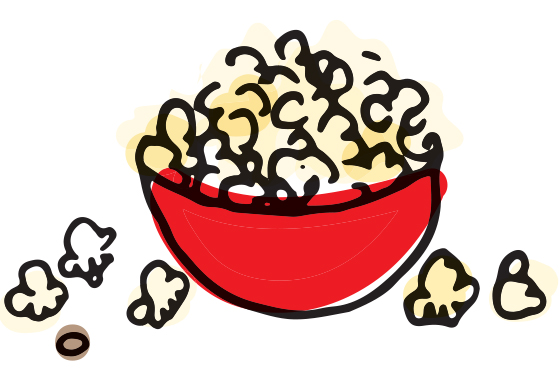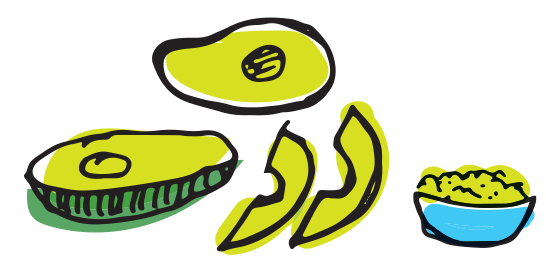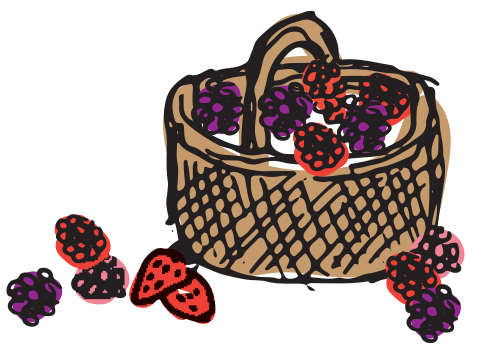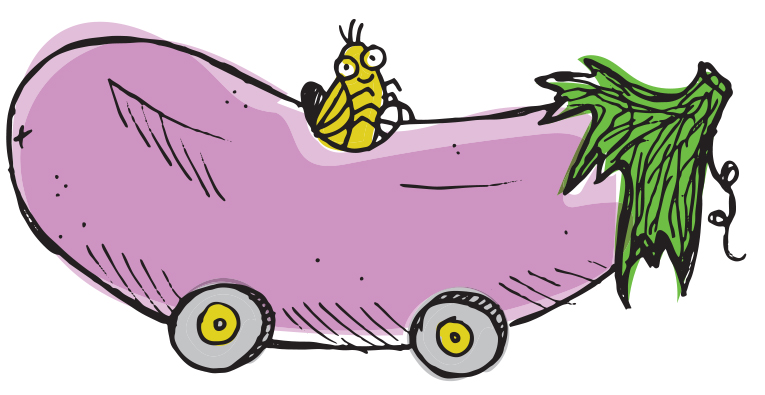by Andy Gricevich, Newsletter Writer
Anyone who’s lived or worked with kids knows they can be picky eaters. Combine that with an economy that keeps most adults very busy and a food culture emphasizing the naturally strong appeal of sweets and simple starch, and it’s no surprise that it can be challenging to offer snacks and pack lunches with nutritious food kids will actually eat. Many a lunchbox returns with only the chips or cookies missing, accompanied by a still-hungry young person. Many a parent bends over backwards to tailor foods to their kids’ particular desires while still getting some nutrients into their bodies, only to find their attempts futile. What’s needed are delicious things to eat that make things easy for both kids and adults. As with so many things, most of the likely solutions are simple.
BETTER CARBS
 Kids, like all of us, love carbohydrates, whether they come in the form of bread, crackers, and chips, or as sugar in cookies and candy. There’s nothing fundamentally wrong with carbs; along with fat and protein, they’re among the macronutrients we all need. It’s just that the simple carbohydrates we find most available in the grocery store break down too quickly in our bodies, causing high-energy spikes and crashing lows, affecting mood and immune function and potentially leading to diabetes and obesity if we make them the center of our diets for too long.
Kids, like all of us, love carbohydrates, whether they come in the form of bread, crackers, and chips, or as sugar in cookies and candy. There’s nothing fundamentally wrong with carbs; along with fat and protein, they’re among the macronutrients we all need. It’s just that the simple carbohydrates we find most available in the grocery store break down too quickly in our bodies, causing high-energy spikes and crashing lows, affecting mood and immune function and potentially leading to diabetes and obesity if we make them the center of our diets for too long.
Fortunately, there are plenty of tasty, healthier sources of both grain-based and sweet carbohydrates. Popcorn is a much more nutritious snack than you might think—a whole-grain food full of fiber, vitamins and minerals. You may see recommendations to only serve air-popped corn with little on it, but popcorn made with a high-quality oil meant to take high heat, and dressed with good, preferably grass-fed butter will give the kids beneficial fats as well (or, if you go for nutritional yeast, additional B vitamins).
Whole-grain breads and crackers are readily available these days, and contain more nutrients, as well as carbs that are absorbed more slowly, than products made with white flour. Whole grains also contain some compounds that block mineral absorption when consumed in excess. If available, go for sourdoughs and sprouted grains, since the fermentation and soaking involved in making those turns off those compounds and unlocks more vitamins—as well as, for some people, failing to cause problems for some people with gluten sensitivities.
We’ve gone way beyond potato chips when it comes to healthier snacks. These days you can get Cheeto-style puffs made from peas, seasoned crackers made from lentils, and chips consisting of corn and an assortment of dried veggies. These treats can often be high in protein, vitamins, minerals, and good fats.
When it comes to sweets, there’s always fruit! Whether they’re fresh and in season, dried, or in the form of fruit leather or all-fruit gummies, berries, bananas, citrus and more are usually sure to please. The sugar in honey is absorbed more slowly than cane or beet sugar, and it contains numerous beneficial nutrients. Maple syrup is full of minerals and antioxidants, and includes a compound that counteracts the “spike/crash” effect. Either of these sweeteners is great with grass-fed yogurt, granola, or oatmeal (organic is important with oats, which are otherwise often subject to extreme herbicide treatment). Satisfy the sweet tooth with natural sugars!
CARBS TO FATS
One great move is to push snacks and lunches away from carbohydrates and toward good and delicious fats. Fortunately, it turns out that all fats—unless they’re hydrogenated, or have gone rancid—are nutritious, even saturated fats, which kids need more than anyone else. Plus, while the quick sugar rush we get from simple carbs definitely hits pleasure centers in our brain—inherited from the time when sweets were rare and precious calorie sources for our ancestors—fat also has a strong, instinctive appeal.
Some kids hate sardines. If you’re lucky, the kids in your life will love them, and there’s no better animal food; tiny fish don’t accumulate toxins like the fish who eat them do. They’re packed with Omega-3 fatty acids (the kind of fat that makes up a third of our brain!), as well as crucial vitamin D. If you get the ones whose nearly imperceptible bones have been left in, they provide gigantic amounts of calcium—and they’re great on a cracker. All you may have to do is provide extra, so people can share, and nobody has to be the only one smelling like fish.
Meat sticks and (especially) beef jerky can keep a belly feeling full, and are fun to gnaw on. They keep well in a lunch box, and offer a lot of essential protein. Grass-fed beef also has the right balance of fats for optimal nutrition, and you can feel good about the often radical ecological benefits of the grazing associated with that kind of meat.
Nuts are every bit the superfood we’ve been told they are. Full of healthy fats, they’re delicious and easy to pack. Most kids love a classic PB&J, and, for those with peanut allergies, there are yummy alternatives available, including cashew, walnut, hazelnut and almond butter. Incidentally, like all plant foods, nuts contain antinutrients—in this case, phytates—which can block the body’s ability to absorb calcium and other minerals. It’s not a problem when nuts are eaten in moderation—just take a break now and then to let the kids’ bodies clean themselves out. If you’re providing nuts every day, and have the time, you can soak them overnight and dry or roast them to deactivate phytates. You’ll also definitely want to favor organic products, since some nuts—especially almonds—get very heavy herbicide treatments on conventional farms.
 Speaking of superfoods, throw in a hard-boiled egg! Eggs are amazing sources of healthy fats, good cholesterol, and many critical nutrients that regulate mood, build strong bones, and more. For a perfect egg, put it in cold water, bring to a boil, turn the heat off, cover the pot, and wait seven minutes before draining and covering with cold water. Add a chunk of cheese (again, grass-fed milk will make for better fats), and you have a high-protein, nourishing snack most kids will love.
Speaking of superfoods, throw in a hard-boiled egg! Eggs are amazing sources of healthy fats, good cholesterol, and many critical nutrients that regulate mood, build strong bones, and more. For a perfect egg, put it in cold water, bring to a boil, turn the heat off, cover the pot, and wait seven minutes before draining and covering with cold water. Add a chunk of cheese (again, grass-fed milk will make for better fats), and you have a high-protein, nourishing snack most kids will love.
Avocado is another great and delicious source of good fats. If no-one’s around to help cut a whole avocado, some good store-bought or home-made guacamole is an excellent choice. Whole-grain crackers, corn chips, carrot sticks, and other veggies are great for dipping. The same goes for hummus, especially when it’s made with a lot of high-quality olive oil. It provides protein and a number of other vitamins, and can also make a great sandwich—try it with pickles, whose acids stimulate digestion and wake up the palate.
KID FORAGERS
For everyday, easy snacking, nothing beats spending some time outside with the kids and nibbling on wild food. It’s amazing how little ones who won’t touch a vegetable on their dinner plates can go nuts for leaves once they learn about the edible plants growing (literally) like weeds all around them. Picking summer berries makes memories that last a lifetime—and wild food, in season, provides nutritional benefits that often exceed even the best organic produce.
We needn’t be intimidated by calling it “foraging.” Eating wild is a natural, instinctive part of our heritage, and much of what’s “wild” and abundant is here due to human disturbance. There are plenty of edible plants around us that are easy to safely identify, and that kids can come to think of as delicious friends.
Again, berries are a gateway food for many of us, and in our region we have an amazing variety and quantity. Black raspberries and blackberries grow along bike paths and along the edges of prairies and wooded places; be prepared for scratched legs, mosquito bites, and snacks kids will want in their lunchbox to take to summer camp. Mulberries are everywhere, and have a long season, ripening in waves and falling from the trees. Serviceberry trees don’t grow wild here, but they’re planted as ornamentals in parks and outside many apartment buildings and shopping malls. Their small, red to deep purple fruits resemble blueberries, and taste something like them, with a pronounced note of almond. Since they don’t have many pest issues, it’s safe to assume that these plantings haven’t been treated with herbicide. Gooseberries grow on bushes, and can often be found in large numbers in sunny spots in the woods, recognizable by their often-intimidating thorns and their small, round fruit with a little “tail” hanging from the bottom. As always, know what you’re eating before you eat it.
 A great rule of thumb to know for concerned adults is this: if a berry is made up of drupelets—those little round balls that make up a blackberry or raspberry—then it’s an edible berry (this doesn’t help with serviceberries and gooseberries, but they’re easy to learn, and have no dangerous lookalikes). As well as being delicious and fun to collect, all these fruits contain compounds (like resveratrol and anthocyanins) that support the immune system and help protect our skin from ultraviolet radiation, just at the time of year we need them. In the unlikely event that anyone gets tired of just eating them on their own, wild berries make fabulous crisps and pies, additions to yogurt, and (dried) fruit leather and ingredients in trail mix.
A great rule of thumb to know for concerned adults is this: if a berry is made up of drupelets—those little round balls that make up a blackberry or raspberry—then it’s an edible berry (this doesn’t help with serviceberries and gooseberries, but they’re easy to learn, and have no dangerous lookalikes). As well as being delicious and fun to collect, all these fruits contain compounds (like resveratrol and anthocyanins) that support the immune system and help protect our skin from ultraviolet radiation, just at the time of year we need them. In the unlikely event that anyone gets tired of just eating them on their own, wild berries make fabulous crisps and pies, additions to yogurt, and (dried) fruit leather and ingredients in trail mix.
You’re likely to have many green plants around you that kids can learn to eat as well. For a common nibble everyone loves, try wood sorrel, often called “sour clover.” Wood sorrel grows in sidewalk cracks, garden beds, and along any sunny edge habitat. It looks like clover, but has heart-shaped leaves and tiny yellow flowers, and offers a lemony flavor. It can also be made into pestos, or sprinkled onto a salad. Another surefire hit is the tender tendrils at the end of a wild grapevine. Wild grape grows almost everywhere around here. The tendrils boast another pleasantly sour flavor, and the fruit—which looks exactly like a bunch of small purple grapes hanging in familiar clusters—has the deepest grape flavor imaginable (though wild grapes are much less sweet than the grapes from the grocery store, and eating too many can give you an itchy throat).
Dandelions and violets, unless they’re intentionally eliminated, grow in almost every yard and park, and are both staggeringly nutritious. Kids love to eat the flowers of both, and the leaves can be added to “yard salads” (though dandelion can be bitter—which is a great way for kids to potentially develop that part of their palate). If you have a garden, you’re likely to find lambs’ quarters or purslane growing as weeds. Lambs’ quarters are essentially wild spinach, and can be eaten raw or cooked in similar ways. Purslane has a crisp, succulent texture and a flavor that ranges from mild to (again) pleasantly lemony.
You’re also likely in the vicinity of wild (or escaped) members of the onion and mint families, which offer two more great wild food rules-of-thumb. If a plant looks like green onions or chives, and smells like them when crushed, it’s in the garlic-onion family, and can be eaten (kids who think they don’t like the strong flavors of these plants often make exceptions when they find them in the outdoors). If a plant has a distinctly square stem, and smells like a culinary herb (like mint, rosemary or thyme, for example), it’s an edible member of the mint family.
Wild plants, because they haven’t been bred for storage, shipment, and consistency, retain the qualities that make them exceptionally healthy food, even when growing in poor soil. Snacking on them gives kids outdoor time and deepens connection with nature. It can distract them from their appetite for carbs and sugar, and—for those of them inclined to play in the kitchen—can often inspire them to create concoctions of their own.
ENGAGEMENT
Whether it’s in the store, the yard or the kitchen, getting kids involved in their own food can often be one of the best ways to nudge them toward healthier eating. Make it fun for them to assemble their own snacks and come up with lunch creations of their own. Present simple, delicious ingredients and let them go to town. Eat seasonally and locally, and they’ll be more likely to get excited about what’s at its best right now (“strawberries are back!”). Have cut-up veggies and easy-to-eat fruits on hand. Most importantly, don’t stress too much. A little that’s sweet, some good starch, some fats and a little salt will satisfy almost any palate, and, if you switch foods out and pick things that are versatile, the kids won’t get bored. Eating can be a joy for everyone!










